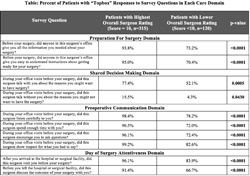|
|
Back to 2014 Annual Meeting Abstracts The Surgical Care Survey Is an Accurate Measure of Patient Satisfaction Across Surgical Care Domains Ryan K. Schmocker*, Linda Cherney Stafford, Alexander Siy, Glen Leverson, Emily Winslow Department of Surgery, University of Wisconsin, Madison, WI
Background: With the introduction of the Affordable Care Act, the patient experience has been increasingly emphasized. Patient satisfaction outcomes are currently measured using the Hospital Consumer Assessment of Healthcare Providers & Systems (HCAHPS) survey, however this tool does not assess information specific to surgical patients. The American College of Surgeons-sponsored and National Quality Forum-endorsed Surgical Care Survey focuses on the characteristics of surgical care that impact the patient experience. We set forth to identify which factors impact overall surgeon rating. Methods: All patients undergoing a general surgical operation at our institution from 6/13-11/13 were sent the Surgical Care Survey within 3 days of discharge. Secondary mailings were sent to nonresponders for the first 226 patients. Survey responses were entered into an ongoing database, as part of a prospective study examining surgical readmissions. Data was analyzed using the highest response as the "Topbox" score. Data analysis was generated using SAS software, with appropriate application of χ2 and t-tests for univariate analysis. Results: The response rate for the 1123 surveys sent was 40.4%. The average age was 59±16 yrs, length of stay was 4.0±6.6 days, and 23% had unscheduled operations. 27.1% of patients were treated by colorectal surgeons, 27.1% by burn/trauma/acute care surgeons, 16.7% by minimally invasive surgeons, and the remainder by breast, hepatobiliary, and endocrine surgeons. Of those who responded to the overall surgeon rating item ("What number would you use to rate all your care from this surgeon?"), 72% (315) rated their surgeon as the best surgeon possible (10 = highest score). Elective operations (p < 0.0001) and older patient age (p = 0.014) were associated with higher ratings. Additionally, there were differences between practice groups and satisfaction (p < 0.0001), with those undergoing endocrine or hepatobiliary procedures having highest scores and those undergoing burn/trauma/acute care procedures having the lowest scores. Dramatic differences were seen in surgeon rating as a function of each care domain examined. Specifically, those patients who reported adequate information giving before surgery, participation in shared decision making, and effective patient-surgeon communication rated their surgeons most highly (Table). Conclusion: The Surgical Care Survey is a new patient satisfaction measure that is a valid tool to elucidate patient satisfaction specific to surgeons. Further, it demonstrates the essential domains that impact patient ratings of their surgeons: effective communication, shared decision-making, adequate preparation for surgery, and surgeon attentiveness on the day of surgery. This information helps surgeons to identify potential areas for improvement that will positively affect the surgical patient experience. Back to 2014 Annual Meeting Abstracts |
||||||||||
© 2025 Society for Surgery of the Alimentary Tract. All Rights Reserved. Read the Privacy Policy.


